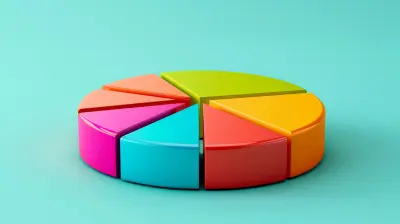Using Stop-Loss Orders to Minimize Day Trading Losses
8 June 2025
Day trading can feel like riding an emotional rollercoaster. One moment, you're up a few hundred bucks, and the next, you're pulling your hair out watching red numbers flash across your screen. If you've been in the game long enough, you know that losses are inevitable. But just because you can't dodge them completely doesn't mean you're helpless.
That's where stop-loss orders come in.
Think of them like airbags for your trades—they may not prevent an accident, but they sure can reduce the damage. So, let's dig into how you can use stop-loss orders to save your sanity and, more importantly, your capital.
What Is a Stop-Loss Order Anyway?
Alright, let’s break it down.A stop-loss order is a preset instruction you give your broker to sell (or buy, in the case of a short) a security once it hits a specific price. The goal? To cap your losses before they snowball into something catastrophic.
For example, say you bought a stock at $100. You set a stop-loss order at $95. If the price falls to $95, your broker automatically sells the stock. Boom! You’re out of the trade before things get really ugly.
Sounds useful, right? That’s because it is.
Why You Absolutely Need a Stop-Loss Strategy
Let’s get real for a second: trading without a stop-loss is like driving without brakes. Sure, the ride might feel thrilling for a minute, but it’s only a matter of time before you crash.Here’s why stop-losses are non-negotiable:
1. They Protect Your Capital
Capital is your lifeblood in trading. Lose too much of it, and you're out of the game. Stop-losses put a safety net under your positions, helping you stay alive to trade another day.2. They Take Emotion Out of the Equation
When money’s on the line, emotions can cloud your judgment. Panic, greed, fear—you name it. A stop-loss acts like an autopilot that kicks in when things go south, keeping you from making impulsive decisions you'd regret later.3. They Improve Your Discipline
Let’s be honest: it’s easy to ignore a loss and hope a trade "comes back." But hope isn't a strategy. Setting a stop-loss forces you to plan ahead and stick to your rules.
Types of Stop-Loss Orders
Not all stop-losses are created equal. Let’s go through the different flavors so you can pick the one that fits your trading style.1. Fixed Stop-Loss
This is your classic stop-loss. You set a specific dollar amount or percentage at which you’ll exit the trade.Example: Buy at $50, set stop-loss at $47 (a 6% loss).
Pros: Simple to understand and implement.
Cons: Doesn’t adapt to market conditions.
2. Trailing Stop-Loss
This one’s a bit fancier. A trailing stop moves with the price when it heads in your favor but stays still if the price turns against you.Example: Buy at $100 with a $5 trailing stop. If the stock moves to $110, your stop moves up to $105. If the stock drops to $105, you’re out.
Pros: Locks in profits while limiting losses.
Cons: Can get triggered by normal price fluctuations (aka market noise).
3. Percentage Stop-Loss
Instead of a fixed dollar amount, you risk a percentage of the price or your account balance.Example: Risk 2% of a $10,000 account = $200. Based on trade strategy, you set a stop-loss to limit losses to $200.
Pros: Helps with consistent risk management.
Cons: Requires some math and strategy to set properly.
How to Set the Right Stop-Loss Level
Here’s the million-dollar question: where do you actually place your stop-loss?Too tight, and you get stopped out on normal fluctuations. Too wide, and you risk taking a bigger hit than you’re comfortable with.
So, what’s the sweet spot?
1. Support and Resistance Levels
These are key price levels where a stock tends to bounce (support) or fall (resistance). Placing a stop just below support (for longs) or above resistance (for shorts) makes logical sense.Why? Because if those levels are broken, the trend might be reversing.
2. Volatility-Based Stops
Volatility tells you how much a stock typically moves. More volatile stocks require wider stop-losses.Use tools like the Average True Range (ATR) to set a stop that accounts for normal price fluctuations.
3. Technical Indicator Stops
Some traders use moving averages, Bollinger Bands, or other indicators as dynamic levels for stop placement.For example, you might trail a stop just below the 20-period moving average in a strong uptrend.
4. Dollar or Percentage Risk
This is where you calculate how much you're willing to lose on a single trade. Then, based on your entry point and position size, set the stop accordingly.Quick formula:
`(Stop Loss in $ / Trade Risk in $) = Number of Shares`
Common Mistakes to Avoid
Even though stop-losses are there to protect you, using them wrong can do more harm than good. Here are the common traps:❌ Placing Stops Too Tight
If your stop is too close to your entry price, you'll get kicked out of trades that might’ve gone your way. Give the trade room to breathe.❌ Moving Your Stop (Without a Plan)
This is the classic “just a little lower” trap. Unless you've got a solid strategy behind it, moving your stop usually ends in disaster.❌ Ignoring Market Conditions
In volatile markets, regular stop-loss distances may not cut it. Always adapt your strategy based on what the market's doing.❌ Using Round Numbers
Traders love round numbers—and algorithms know it. If everyone’s placing stops at $50, yours might get hit prematurely. Think outside the box. Try $49.75 instead.Real Talk: Stop-Losses Aren’t Perfect
Let’s not sugarcoat it—stop-losses aren’t foolproof.Heavy market gaps can cause "slippage," where your order gets filled at a worse price than expected. And sudden volatility can trigger your stop, only for the stock to rebound five minutes later.
Frustrating? Yes. But that’s still better than holding the bag on a 20% loss.
Stop-Losses and Psychology: Winning the Mental Battle
Using stop-loss orders isn’t just about math—it’s about mindset.You’ve got to be okay with being wrong sometimes. And that can be tough. Our brains are wired to avoid losses at all costs (thank you, loss aversion bias).
But here’s the mindset shift: Taking a small loss is a strategic win.
It protects your account, preserves your mental energy, and keeps you in the game.
So next time your stop gets triggered, don’t see it as a failure. See it as a calculated decision that did its job.
Pro Tips for Mastering Stop-Loss Orders
Let’s round things off with a few practical tips you can apply starting now:✓ Always define your risk before entering a trade
Know how much you’re willing to lose. Then pick your stop-loss spot accordingly.
✓ Use alerts in addition to stop orders
Sometimes, manual intervention makes more sense, especially during high-volatility periods.
✓ Reassess your stop-loss strategy regularly
What worked yesterday might not work tomorrow. Be flexible and ready to adapt.
✓ Backtest your strategy
Before going live, make sure your stop-loss approach makes sense historically.
✓ Never “hope” a trade turns around
Hope is not a trading plan. Have a stop, and stick with it.
Final Thoughts
Day trading is tough—no sugarcoating it. But tools like stop-loss orders can make all the difference between blowing up your account and living to fight another day.Think of stop-losses as your personal risk manager. They don’t just reduce losses—they help you trade smarter, stay disciplined, and keep a cool head when the market starts throwing punches.
So whether you’re just starting out or you’re a seasoned trader who’s taken one too many hits, it's never too late to tighten up your risk game.
And if there’s one thing you take away from this post, make it this:
👉 _“Small losses are the tuition you pay to learn. Big losses are the ones that empty your bank account.”_
Set your stops. And stick to them.
all images in this post were generated using AI tools
Category:
Day Trading BasicsAuthor:

Zavier Larsen
Discussion
rate this article
3 comments
Rhea Kirkland
This article beautifully captures the importance of stop-loss orders in day trading. It’s a reminder that protecting our investments is just as crucial as seeking gains. Thank you for shedding light on such a vital strategy—it's a lifeline for traders navigating the unpredictable market waters. Your insights are truly appreciated!
June 21, 2025 at 12:30 PM

Zavier Larsen
Thank you for your kind words! I'm glad you found the article helpful in emphasizing the importance of stop-loss orders in day trading. Protecting investments is indeed crucial!
Mateo McCoy
Stop-loss orders are essential for protecting your capital in day trading.
June 9, 2025 at 12:50 PM

Zavier Larsen
Thank you for your comment! Absolutely, stop-loss orders play a vital role in safeguarding capital and managing risk in day trading.
Kira Acevedo
Great insights on stop-loss orders! They’re a fantastic tool for day traders to protect their investments while keeping emotions in check. Implementing these strategies can truly lead to more confident trading and better overall results. Happy trading!
June 8, 2025 at 12:21 PM

Zavier Larsen
Thank you for your thoughtful comments! I'm glad you found the insights on stop-loss orders valuable for confident trading. Happy trading to you too!



